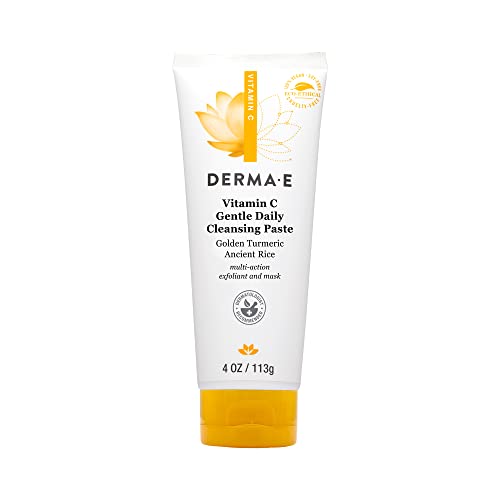
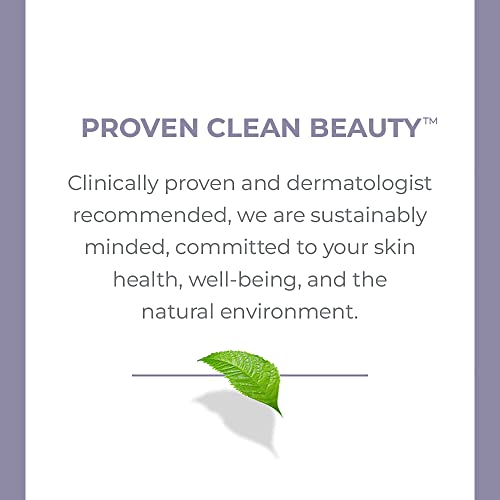
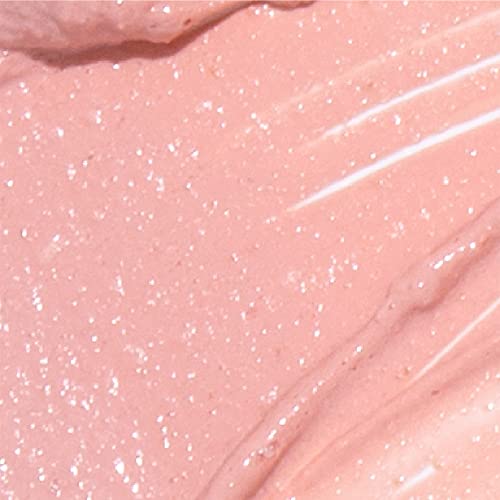
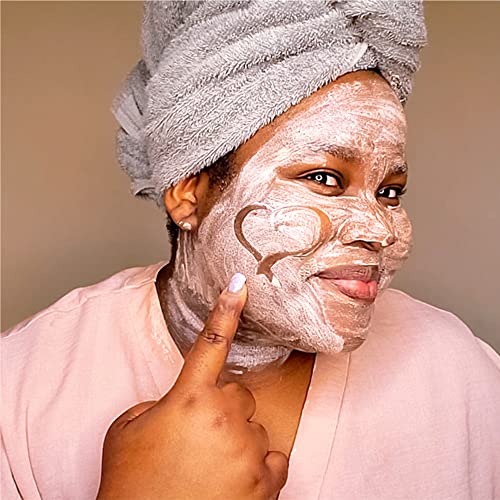
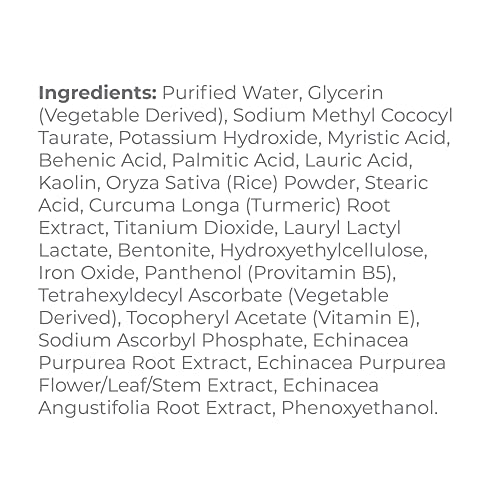
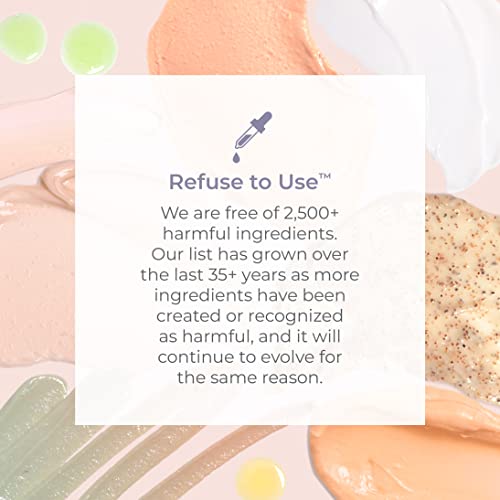
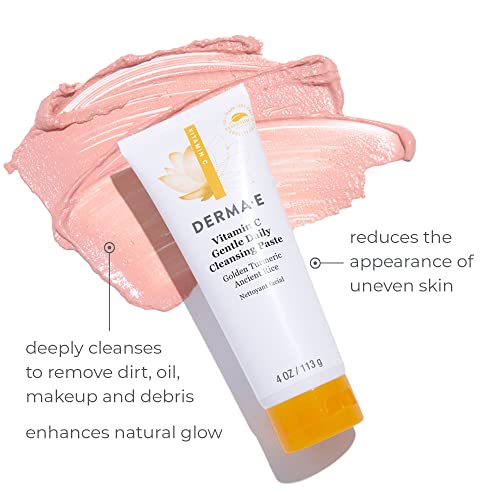
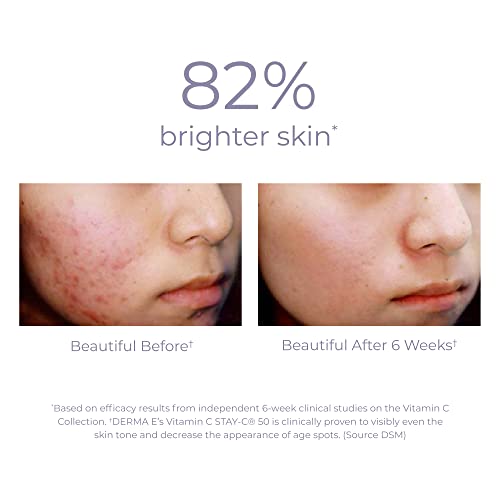
Derma E Vitamin C Face Wash - Brightening & Clarifying with Turmeric, 100% Vegan - 4oz


Potassium Hydroxide
High RiskPotassium hydroxide is a caustic inorganic base commonly used in various products for its ability to adjust pH levels and act as a cleaning agent. It is highly soluble in water and can produce heat upon dissolution, making it effective in certain formulations.
Sustai Insights
Potassium hydroxide serves as a strong pH adjuster and cleaning agent, but it poses significant health risks due to its caustic nature, which can cause irritation to skin and eyes. Environmental concerns include its potential to contribute to water pollution. Regulatory bodies have imposed strict usage restrictions due to these hazards, leading to a high-risk overall assessment. Safe handling practices are essential, and alternatives such as citric acid may provide safer pH adjustment without the associated risks.
Bentonite
Medium RiskBentonite is a native hydrated colloidal aluminum silicate clay that is utilized in various products for its binding, thickening, and absorbent properties. It serves functions such as stabilizing emulsions and enhancing texture in formulations.
Sustai Insights
Bentonite offers functional benefits as a thickening agent and stabilizer, and it is often sourced sustainably. It has low concerns for carcinogenicity, allergies, and developmental toxicity, but moderate use restrictions exist. Environmental risks include potential pollutant characteristics. Regulatory bodies have noted these restrictions, suggesting careful usage. Overall, the risk level is assessed as medium, and users are advised to consider alternatives like kaolin clay for similar properties.
Glycerin
Medium RiskGlycerin (also called glycerol) is a naturally occurring compound commonly used in personal care and cosmetic products. It functions as a humectant, attracting moisture to the skin, and is also utilized as a solvent and emollient to enhance product texture and stability.
Sustai Insights
Glycerin is valued for its effective moisturizing properties and biodegradability, making it a widely accepted ingredient in formulations. It poses low health risks, including low concerns for carcinogenicity and allergies. However, moderate use restrictions exist due to regulatory guidelines. While glycerin does not significantly contribute to environmental pollution, its production process should be ethically sourced. Overall, glycerin holds a medium risk level, emphasizing the importance of safe usage practices and considering sustainable alternatives.
Phenoxyethanol
Medium RiskPhenoxyethanol is a preservative used in cosmetics and personal care products to prevent microbial growth and extend shelf life. It is commonly found in formulations such as lotions, creams, and serums.
Sustai Insights
Phenoxyethanol serves effectively as a preservative, ensuring product stability and safety by inhibiting microbial growth. It is considered to have low health risks regarding carcinogenicity, allergies, and reproductive toxicity. However, moderate use restrictions exist, and regulatory bodies have advised caution in specific applications. Environmental concerns include its potential as a pollutant, although it is not highly bioaccumulative. Overall, the ingredient presents a medium risk level, with safe usage practices recommended and alternative preservatives available for those seeking greener options.
Titanium Dioxide
Medium RiskTitanium dioxide is an inorganic compound used primarily as a pigment due to its brightness and high refractive index. It is commonly found in products such as paints, coatings, plastics, and cosmetics, providing color and opacity.
Sustai Insights
Titanium dioxide serves effectively as a UV filter and colorant, enhancing product stability and performance. However, it has been classified as a moderate concern for potential carcinogenicity and carries low risks for allergies and reproductive toxicity. Environmental risks include its pollutant potential, though it is not known to bioaccumulate. Regulatory bodies have issued specific restrictions regarding its use, leading to an overall medium risk assessment. Safe usage practices should be observed, with consideration for alternatives such as zinc oxide for a more sustainable option.
Tocopheryl Acetate
Medium RiskTocopheryl acetate is a chemical compound that serves primarily as a form of Vitamin E. It is used in cosmetic and personal care products for its antioxidant properties and to enhance skin stability and moisture.
Sustai Insights
Tocopheryl acetate is valued for its functional benefits, including acting as an antioxidant and skin conditioning agent. It is generally considered to have low carcinogenicity and reproductive toxicity risk, although it poses a moderate concern for allergies. Environmental risks are minimal, with no significant pollutant or bioaccumulation potential noted. Regulatory bodies have not imposed significant restrictions. Safe usage practices should be followed, particularly regarding enhanced skin absorption. Alternatives like natural Vitamin E may provide similar benefits with potentially lower allergenic properties. Overall, this ingredient presents a medium risk assessment.
Behenic Acid
Low RiskBehenic acid is a fatty acid primarily used in cosmetic formulations for its emollient and thickening properties. It is derived from natural sources, such as the seeds of the Moringa tree, and is commonly found in creams, lotions, and hair products.
Sustai Insights
Behenic acid offers functional benefits as an effective emollient that enhances product texture and moisture retention. It is considered low risk for health concerns, including carcinogenicity and allergens, with minimal reported irritation. Environmentally, it is not known to be a pollutant or bioaccumulative. Regulatory agencies, including Environment Canada, impose low restrictions on its use. Overall, it presents a low-risk profile, making it a suitable ingredient in personal care products. Alternatives such as other fatty acids or plant-based emollients may also be explored.
Tetrahexyldecyl Ascorbate
Low RiskTetrahexyldecyl ascorbate is an ester of hexyl ascorbic acid, a stable form of vitamin C, commonly used in cosmetic formulations for its antioxidant properties. It is employed to improve skin appearance, enhance radiance, and provide photoprotection.
Sustai Insights
Tetrahexyldecyl ascorbate offers functional benefits as an antioxidant, promoting skin health and appearance. It is generally regarded as safe, with low concerns for carcinogenicity, allergies, and irritation. Although it poses minimal environmental risks, regulatory bodies have outlined specific usage guidelines. Overall, its risk level is assessed as low, making it a viable option in cosmetic formulations.
Lauric Acid
Low RiskLauric acid is a naturally occurring fatty acid commonly found in coconut oil and palm kernel oil. It is primarily used as an emollient, surfactant, and antimicrobial agent in various personal care and cosmetic products due to its potential to enhance product texture and stability.
Sustai Insights
Lauric acid offers functional benefits as an effective emollient and antimicrobial agent, contributing to skin hydration and product preservation. It is biodegradable and derived from renewable sources. Health risks are minimal, with low concerns for carcinogenicity, allergenicity, and reproductive toxicity. Environmental impacts are also low, with no significant pollutant or bioaccumulation potential. Regulatory assessments, including those from the FDA and cosmetic safety reviews, indicate its safe use in products. Overall, lauric acid is considered low risk, making it a viable ingredient in formulations.
Sodium Ascorbyl Phosphate
Low RiskSodium ascorbyl phosphate is a salt of ascorbic acid (vitamin C) commonly used in cosmetic formulations. It acts as an antioxidant and is often included for its ability to brighten skin and enhance the stability of products by preventing oxidation.
Sustai Insights
Sodium ascorbyl phosphate provides functional benefits as an antioxidant and skin-brightening agent, contributing to product efficacy. It is considered low risk regarding health impacts, with minimal concerns for carcinogenicity, allergies, or reproductive toxicity. Environmentally, it does not present significant hazards. Regulatory bodies do not impose severe restrictions, classifying it as safe for use. Overall, the risk level associated with this ingredient is low, making it a suitable choice in cosmetic formulations.
Echinacea Purpurea (Purple Cornflower) Root Extract
Low RiskEchinacea purpurea root extract is derived from the purple coneflower and is commonly used in herbal remedies. Its primary function is to support immune health, often included in dietary supplements and natural health products for its purported benefits in enhancing immune response.
Sustai Insights
Echinacea purpurea root extract offers functional benefits, particularly in supporting immune function and promoting overall health. It is sustainably sourced and generally regarded as safe, with low concerns regarding carcinogenicity, allergenic potential, and reproductive toxicity. Despite its positive attributes, it may cause mild irritation in some individuals and has minimal environmental risks, not contributing significantly to pollution or bioaccumulation. Regulatory bodies do not impose restrictions on its usage. Overall, the ingredient is assessed as low risk, making it a favorable option in health formulations.
Hydroxyethylcellulose
Low RiskHydroxyethylcellulose is a modified cellulose polymer used primarily as a thickening agent and stabilizer in various cosmetic and personal care products. It is soluble in water and helps to improve the texture and viscosity of formulations, enhancing their usability and performance.
Sustai Insights
Hydroxyethylcellulose offers functional benefits such as effective thickening and stabilization in formulations, contributing to product texture. It is generally considered low-risk in terms of health, with minimal concerns regarding carcinogenicity, allergens, or reproductive toxicity. Environmentally, it poses low risks and is not known to be bioaccumulative. Regulatory bodies have not imposed significant restrictions on its use. Safe practices include adhering to recommended concentrations, and while alternatives exist, hydroxyethylcellulose remains a low-risk ingredient overall.
Palmitic Acid
Low RiskPalmitic acid is a naturally occurring fatty acid found in animals and plants. It is commonly used in cosmetic and food products as an emulsifier, thickener, and stabilizer, contributing to texture and consistency.
Sustai Insights
Palmitic acid effectively acts as an emulsifier and thickener, enhancing product texture. It is biodegradable and derived from renewable sources, supporting sustainability. Health risks are low, with no significant concerns regarding carcinogenicity, allergies, or reproductive toxicity. Environmentally, it poses minimal risks, with no known pollutant or bioaccumulative effects. Regulatory bodies, including the FDA, have not issued significant restrictions. Overall, the ingredient is assessed as low risk, making it a safe choice in formulations.
Echinacea Purpurea (Purple Coneflower) Extract
Low RiskEchinacea purpurea extract is derived from the purple coneflower, known for its use in herbal remedies. It is primarily included in products for its purported immune-boosting properties and is commonly used in dietary supplements and cosmetics.
Sustai Insights
Echinacea purpurea extract offers functional benefits such as potential immune support and anti-inflammatory properties. It is sustainably sourced and biodegradable. Health risks are low, with no significant concerns regarding carcinogenicity, allergens, or reproductive toxicity. There are no notable environmental hazards, and it is not restricted by regulatory bodies. Overall, the risk level associated with this ingredient is low. Safe usage practices should be followed, and alternatives may include other herbal extracts with similar benefits.
Echinacea Angustifolia (Coneflower) Root Extract
Low RiskEchinacea angustifolia (coneflower) root extract is derived from the roots of the echinacea plant, commonly used for its purported immune-boosting properties. It is often included in dietary supplements and topical formulations for its potential health benefits.
Sustai Insights
This ingredient is recognized for its functional benefits, particularly in supporting immune health. It is generally considered safe, with low concerns regarding carcinogenicity, allergies, and reproductive toxicity. Environmental risks are minimal, and it is not classified as a pollutant. There are no current restrictions on its use from regulatory bodies. Safe usage practices should be maintained, and alternatives include other herbal extracts with similar immune-supporting properties. Overall, the risk assessment indicates a low risk for health and environmental impacts.
Curcuma Longa (Turmeric) Root Extract
Low RiskCurcuma longa (turmeric) root extract is an extract from the turmeric plant, commonly used for its coloring and potential health benefits in various products. It is recognized for its active compound, curcumin, which is studied for its anti-inflammatory and antioxidant properties.
Sustai Insights
Curcuma longa (turmeric) root extract is valued for its functional benefits, including potential anti-inflammatory and antioxidant effects, contributing positively to formulations. It is biodegradable and often sustainably sourced. Health risks are low, with no significant concerns regarding carcinogenicity or irritation. Environmental risks are minimal, with no evidence of bioaccumulation. Regulatory bodies have not placed restrictions on its use, supporting a low-risk assessment overall. Safe usage practices should be adhered to, but there are few concerns for sensitive populations. Alternatives like ginger extract may provide similar benefits.
Sodium Methyl Cocoyl Taurate
Low RiskSodium methyl cocoyl taurate is a sodium salt derived from coconut fatty acids, primarily used as a mild surfactant and foaming agent in personal care products. It helps to cleanse and stabilize formulations, contributing to improved texture and performance.
Sustai Insights
Sodium methyl cocoyl taurate is recognized for its effective surfactant properties, providing gentle cleansing and foam production in formulations. It is considered low risk for health concerns such as carcinogenicity and allergenic potential, with minimal irritation noted. Environmentally, it poses low hazards with no significant bioaccumulation or pollution risks. Regulatory bodies, including ECHA, indicate no current restrictions. Overall, it presents a low risk profile, making it a viable choice in personal care applications. Safe usage practices are recommended, and alternatives may include other mild surfactants.
Myristic Acid
Low RiskMyristic acid is an organic acid commonly used in cosmetic and personal care products as an emollient and surfactant. It helps to enhance texture and stability while providing moisturizing properties. Myristic acid is derived from natural sources, including coconut and palm oil.
Sustai Insights
Myristic acid serves as an effective emollient, enhancing product texture and moisture retention. It is generally regarded as safe with low concerns for carcinogenicity, allergies, and reproductive toxicity. However, environmental risks are minimal, and it is not considered bioaccumulative. Regulatory bodies, including the FDA, have not imposed significant restrictions on its use. Overall, the risk associated with myristic acid is low, making it a suitable ingredient for cosmetic formulations.
Kaolin
Low RiskKaolin is a clay mineral composed of hydrated aluminum silicate. It is commonly used in various products for its absorbent properties, acting as a thickener, filler, and anti-caking agent in cosmetics, pharmaceuticals, and food applications.
Sustai Insights
Kaolin offers functional benefits such as effective absorption and thickening, making it valuable in personal care and industrial products. It is generally considered safe, with low concerns related to carcinogenicity, allergies, and reproductive toxicity. Environmental risks are minimal, as it is not known to be a pollutant or bioaccumulative. Regulatory bodies impose few restrictions, underscoring its low-risk profile. Safe usage practices are recommended, and while alternatives exist, kaolin remains a low-risk option in its applications.
Oryza Sativa (Rice) Powder
Low RiskOryza sativa (rice) powder is a powder obtained from the grinding of rice grains. It is commonly used in personal care and cosmetic products for its absorbent properties, texture enhancement, and as a bulking agent.
Sustai Insights
Oryza sativa (rice) powder functions effectively as an absorbent and texturizing agent in various formulations. It is considered low risk for carcinogenicity, allergies, and developmental toxicity, though contamination concerns are notable. Environmental impact is minimal, and it is generally compliant with regulatory standards. Safe usage practices are recommended, and while alternatives exist, their suitability may vary. Overall, the ingredient maintains a low risk level.
Lauryl Lactyl Lactate
Low RiskLauryl lactyl lactate is an ester derived from lauric acid and lactic acid, commonly used in personal care products for its emulsifying and skin-conditioning properties. It aids in improving product texture and stability while enhancing moisture retention in the skin.
Sustai Insights
Lauryl lactyl lactate offers functional benefits such as acting as an effective emulsifier and skin-conditioning agent. It is considered to have low health risks, with no significant concerns regarding carcinogenicity, allergies, or reproductive toxicity. Environmentally, it shows low pollutant potential and is not bioaccumulative. Regulatory bodies have not placed any significant restrictions on its use, further supporting its low-risk status. For safety, it is advisable to use it within established concentrations. Alternatives may include other emulsifiers derived from natural sources, but overall, lauryl lactyl lactate is assessed as low risk.
Stearic Acid
Low RiskStearic acid is a naturally occurring fatty acid commonly found in animal and vegetable fats. It functions primarily as an emulsifier, thickener, and stabilizer in cosmetic and personal care products, providing texture and consistency.
Sustai Insights
Stearic acid offers functional benefits such as effective emulsification and stabilization of formulations. It is derived from renewable sources and is biodegradable, contributing to its sustainability profile. Health risks are low, with minimal concerns regarding carcinogenicity, allergies, or reproductive toxicity. Environmental risks are also low, with no significant pollutants or bioaccumulation concerns noted. Regulatory bodies, including the FDA, do not impose restrictions on its use. Overall, stearic acid is assessed as low risk, and its safe usage practices are well-established, with no significant alternatives needed.
Water
Low RiskWater is a clear, colorless liquid essential for various biological processes. It serves as a solvent in formulations, facilitating the dissolution of other ingredients and enhancing product texture and application. Additionally, water plays a crucial role in hydration and is a key component in many cosmetic and personal care products.
Sustai Insights
Water is an effective solvent and hydrator, contributing to the texture and efficacy of formulations. It is biodegradable and generally regarded as safe, with low concerns regarding carcinogenicity, allergies, and reproductive toxicity. However, excessive water usage can lead to environmental concerns, particularly regarding resource depletion. Regulatory bodies do not impose restrictions on water use in cosmetics. Overall, the risks associated with water are low, making it a safe and essential ingredient.
Ci 77499
Low RiskCI 77499, also known as iron oxides, are inorganic pigments commonly used in cosmetic products for their coloring properties. They provide a range of shades and are often included for their stability and opacity, enhancing the visual appeal of formulations.
Sustai Insights
CI 77499 offers functional benefits as a stable colorant, contributing to product aesthetics without significant health risks, as concerns for carcinogenicity, allergies, and reproductive toxicity are low. However, it has high persistence and bioaccumulation potential in the environment, raising ecotoxicity concerns. Regulatory restrictions exist for certain uses. Overall, the ingredient presents a low risk profile when used according to safety guidelines, with alternatives available for those seeking greener options.
Panthenol
Low RiskPanthenol, a derivative of vitamin B5, is commonly used in cosmetic formulations for its moisturizing and skin-conditioning properties. It acts as a humectant, helping to retain moisture in the skin and hair, thereby improving hydration and texture.
Sustai Insights
Panthenol offers functional benefits such as effective hydration and skin conditioning, making it valuable in various cosmetic products. It is considered low risk regarding health impacts, with minimal concerns about carcinogenicity, allergies, or reproductive toxicity. Environmental risks are also low, with no significant pollutant or bioaccumulation potential. Regulatory bodies have not imposed restrictions on its use. Safe usage practices include adhering to recommended concentrations. Alternatives like glycerin may provide similar moisturizing benefits, but overall, panthenol is assessed as a low-risk ingredient.
Behenic Acid
Low RiskBehenic acid is a fatty acid primarily used in cosmetic formulations for its emollient and thickening properties. It is derived from natural sources, such as the seeds of the Moringa tree, and is commonly found in creams, lotions, and hair products.
Sustai Insights
Behenic acid offers functional benefits as an effective emollient that enhances product texture and moisture retention. It is considered low risk for health concerns, including carcinogenicity and allergens, with minimal reported irritation. Environmentally, it is not known to be a pollutant or bioaccumulative. Regulatory agencies, including Environment Canada, impose low restrictions on its use. Overall, it presents a low-risk profile, making it a suitable ingredient in personal care products. Alternatives such as other fatty acids or plant-based emollients may also be explored.
Tetrahexyldecyl Ascorbate
Low RiskTetrahexyldecyl ascorbate is an ester of hexyl ascorbic acid, a stable form of vitamin C, commonly used in cosmetic formulations for its antioxidant properties. It is employed to improve skin appearance, enhance radiance, and provide photoprotection.
Sustai Insights
Tetrahexyldecyl ascorbate offers functional benefits as an antioxidant, promoting skin health and appearance. It is generally regarded as safe, with low concerns for carcinogenicity, allergies, and irritation. Although it poses minimal environmental risks, regulatory bodies have outlined specific usage guidelines. Overall, its risk level is assessed as low, making it a viable option in cosmetic formulations.
Lauric Acid
Low RiskLauric acid is a naturally occurring fatty acid commonly found in coconut oil and palm kernel oil. It is primarily used as an emollient, surfactant, and antimicrobial agent in various personal care and cosmetic products due to its potential to enhance product texture and stability.
Sustai Insights
Lauric acid offers functional benefits as an effective emollient and antimicrobial agent, contributing to skin hydration and product preservation. It is biodegradable and derived from renewable sources. Health risks are minimal, with low concerns for carcinogenicity, allergenicity, and reproductive toxicity. Environmental impacts are also low, with no significant pollutant or bioaccumulation potential. Regulatory assessments, including those from the FDA and cosmetic safety reviews, indicate its safe use in products. Overall, lauric acid is considered low risk, making it a viable ingredient in formulations.
Sodium Ascorbyl Phosphate
Low RiskSodium ascorbyl phosphate is a salt of ascorbic acid (vitamin C) commonly used in cosmetic formulations. It acts as an antioxidant and is often included for its ability to brighten skin and enhance the stability of products by preventing oxidation.
Sustai Insights
Sodium ascorbyl phosphate provides functional benefits as an antioxidant and skin-brightening agent, contributing to product efficacy. It is considered low risk regarding health impacts, with minimal concerns for carcinogenicity, allergies, or reproductive toxicity. Environmentally, it does not present significant hazards. Regulatory bodies do not impose severe restrictions, classifying it as safe for use. Overall, the risk level associated with this ingredient is low, making it a suitable choice in cosmetic formulations.
Potassium Hydroxide
High RiskPotassium hydroxide is a caustic inorganic base commonly used in various products for its ability to adjust pH levels and act as a cleaning agent. It is highly soluble in water and can produce heat upon dissolution, making it effective in certain formulations.
Sustai Insights
Potassium hydroxide serves as a strong pH adjuster and cleaning agent, but it poses significant health risks due to its caustic nature, which can cause irritation to skin and eyes. Environmental concerns include its potential to contribute to water pollution. Regulatory bodies have imposed strict usage restrictions due to these hazards, leading to a high-risk overall assessment. Safe handling practices are essential, and alternatives such as citric acid may provide safer pH adjustment without the associated risks.
Echinacea Purpurea (Purple Cornflower) Root Extract
Low RiskEchinacea purpurea root extract is derived from the purple coneflower and is commonly used in herbal remedies. Its primary function is to support immune health, often included in dietary supplements and natural health products for its purported benefits in enhancing immune response.
Sustai Insights
Echinacea purpurea root extract offers functional benefits, particularly in supporting immune function and promoting overall health. It is sustainably sourced and generally regarded as safe, with low concerns regarding carcinogenicity, allergenic potential, and reproductive toxicity. Despite its positive attributes, it may cause mild irritation in some individuals and has minimal environmental risks, not contributing significantly to pollution or bioaccumulation. Regulatory bodies do not impose restrictions on its usage. Overall, the ingredient is assessed as low risk, making it a favorable option in health formulations.
Hydroxyethylcellulose
Low RiskHydroxyethylcellulose is a modified cellulose polymer used primarily as a thickening agent and stabilizer in various cosmetic and personal care products. It is soluble in water and helps to improve the texture and viscosity of formulations, enhancing their usability and performance.
Sustai Insights
Hydroxyethylcellulose offers functional benefits such as effective thickening and stabilization in formulations, contributing to product texture. It is generally considered low-risk in terms of health, with minimal concerns regarding carcinogenicity, allergens, or reproductive toxicity. Environmentally, it poses low risks and is not known to be bioaccumulative. Regulatory bodies have not imposed significant restrictions on its use. Safe practices include adhering to recommended concentrations, and while alternatives exist, hydroxyethylcellulose remains a low-risk ingredient overall.
Palmitic Acid
Low RiskPalmitic acid is a naturally occurring fatty acid found in animals and plants. It is commonly used in cosmetic and food products as an emulsifier, thickener, and stabilizer, contributing to texture and consistency.
Sustai Insights
Palmitic acid effectively acts as an emulsifier and thickener, enhancing product texture. It is biodegradable and derived from renewable sources, supporting sustainability. Health risks are low, with no significant concerns regarding carcinogenicity, allergies, or reproductive toxicity. Environmentally, it poses minimal risks, with no known pollutant or bioaccumulative effects. Regulatory bodies, including the FDA, have not issued significant restrictions. Overall, the ingredient is assessed as low risk, making it a safe choice in formulations.
Echinacea Purpurea (Purple Coneflower) Extract
Low RiskEchinacea purpurea extract is derived from the purple coneflower, known for its use in herbal remedies. It is primarily included in products for its purported immune-boosting properties and is commonly used in dietary supplements and cosmetics.
Sustai Insights
Echinacea purpurea extract offers functional benefits such as potential immune support and anti-inflammatory properties. It is sustainably sourced and biodegradable. Health risks are low, with no significant concerns regarding carcinogenicity, allergens, or reproductive toxicity. There are no notable environmental hazards, and it is not restricted by regulatory bodies. Overall, the risk level associated with this ingredient is low. Safe usage practices should be followed, and alternatives may include other herbal extracts with similar benefits.
Echinacea Angustifolia (Coneflower) Root Extract
Low RiskEchinacea angustifolia (coneflower) root extract is derived from the roots of the echinacea plant, commonly used for its purported immune-boosting properties. It is often included in dietary supplements and topical formulations for its potential health benefits.
Sustai Insights
This ingredient is recognized for its functional benefits, particularly in supporting immune health. It is generally considered safe, with low concerns regarding carcinogenicity, allergies, and reproductive toxicity. Environmental risks are minimal, and it is not classified as a pollutant. There are no current restrictions on its use from regulatory bodies. Safe usage practices should be maintained, and alternatives include other herbal extracts with similar immune-supporting properties. Overall, the risk assessment indicates a low risk for health and environmental impacts.
Curcuma Longa (Turmeric) Root Extract
Low RiskCurcuma longa (turmeric) root extract is an extract from the turmeric plant, commonly used for its coloring and potential health benefits in various products. It is recognized for its active compound, curcumin, which is studied for its anti-inflammatory and antioxidant properties.
Sustai Insights
Curcuma longa (turmeric) root extract is valued for its functional benefits, including potential anti-inflammatory and antioxidant effects, contributing positively to formulations. It is biodegradable and often sustainably sourced. Health risks are low, with no significant concerns regarding carcinogenicity or irritation. Environmental risks are minimal, with no evidence of bioaccumulation. Regulatory bodies have not placed restrictions on its use, supporting a low-risk assessment overall. Safe usage practices should be adhered to, but there are few concerns for sensitive populations. Alternatives like ginger extract may provide similar benefits.
Sodium Methyl Cocoyl Taurate
Low RiskSodium methyl cocoyl taurate is a sodium salt derived from coconut fatty acids, primarily used as a mild surfactant and foaming agent in personal care products. It helps to cleanse and stabilize formulations, contributing to improved texture and performance.
Sustai Insights
Sodium methyl cocoyl taurate is recognized for its effective surfactant properties, providing gentle cleansing and foam production in formulations. It is considered low risk for health concerns such as carcinogenicity and allergenic potential, with minimal irritation noted. Environmentally, it poses low hazards with no significant bioaccumulation or pollution risks. Regulatory bodies, including ECHA, indicate no current restrictions. Overall, it presents a low risk profile, making it a viable choice in personal care applications. Safe usage practices are recommended, and alternatives may include other mild surfactants.
Myristic Acid
Low RiskMyristic acid is an organic acid commonly used in cosmetic and personal care products as an emollient and surfactant. It helps to enhance texture and stability while providing moisturizing properties. Myristic acid is derived from natural sources, including coconut and palm oil.
Sustai Insights
Myristic acid serves as an effective emollient, enhancing product texture and moisture retention. It is generally regarded as safe with low concerns for carcinogenicity, allergies, and reproductive toxicity. However, environmental risks are minimal, and it is not considered bioaccumulative. Regulatory bodies, including the FDA, have not imposed significant restrictions on its use. Overall, the risk associated with myristic acid is low, making it a suitable ingredient for cosmetic formulations.
Kaolin
Low RiskKaolin is a clay mineral composed of hydrated aluminum silicate. It is commonly used in various products for its absorbent properties, acting as a thickener, filler, and anti-caking agent in cosmetics, pharmaceuticals, and food applications.
Sustai Insights
Kaolin offers functional benefits such as effective absorption and thickening, making it valuable in personal care and industrial products. It is generally considered safe, with low concerns related to carcinogenicity, allergies, and reproductive toxicity. Environmental risks are minimal, as it is not known to be a pollutant or bioaccumulative. Regulatory bodies impose few restrictions, underscoring its low-risk profile. Safe usage practices are recommended, and while alternatives exist, kaolin remains a low-risk option in its applications.
Oryza Sativa (Rice) Powder
Low RiskOryza sativa (rice) powder is a powder obtained from the grinding of rice grains. It is commonly used in personal care and cosmetic products for its absorbent properties, texture enhancement, and as a bulking agent.
Sustai Insights
Oryza sativa (rice) powder functions effectively as an absorbent and texturizing agent in various formulations. It is considered low risk for carcinogenicity, allergies, and developmental toxicity, though contamination concerns are notable. Environmental impact is minimal, and it is generally compliant with regulatory standards. Safe usage practices are recommended, and while alternatives exist, their suitability may vary. Overall, the ingredient maintains a low risk level.
Bentonite
Medium RiskBentonite is a native hydrated colloidal aluminum silicate clay that is utilized in various products for its binding, thickening, and absorbent properties. It serves functions such as stabilizing emulsions and enhancing texture in formulations.
Sustai Insights
Bentonite offers functional benefits as a thickening agent and stabilizer, and it is often sourced sustainably. It has low concerns for carcinogenicity, allergies, and developmental toxicity, but moderate use restrictions exist. Environmental risks include potential pollutant characteristics. Regulatory bodies have noted these restrictions, suggesting careful usage. Overall, the risk level is assessed as medium, and users are advised to consider alternatives like kaolin clay for similar properties.
Lauryl Lactyl Lactate
Low RiskLauryl lactyl lactate is an ester derived from lauric acid and lactic acid, commonly used in personal care products for its emulsifying and skin-conditioning properties. It aids in improving product texture and stability while enhancing moisture retention in the skin.
Sustai Insights
Lauryl lactyl lactate offers functional benefits such as acting as an effective emulsifier and skin-conditioning agent. It is considered to have low health risks, with no significant concerns regarding carcinogenicity, allergies, or reproductive toxicity. Environmentally, it shows low pollutant potential and is not bioaccumulative. Regulatory bodies have not placed any significant restrictions on its use, further supporting its low-risk status. For safety, it is advisable to use it within established concentrations. Alternatives may include other emulsifiers derived from natural sources, but overall, lauryl lactyl lactate is assessed as low risk.
Stearic Acid
Low RiskStearic acid is a naturally occurring fatty acid commonly found in animal and vegetable fats. It functions primarily as an emulsifier, thickener, and stabilizer in cosmetic and personal care products, providing texture and consistency.
Sustai Insights
Stearic acid offers functional benefits such as effective emulsification and stabilization of formulations. It is derived from renewable sources and is biodegradable, contributing to its sustainability profile. Health risks are low, with minimal concerns regarding carcinogenicity, allergies, or reproductive toxicity. Environmental risks are also low, with no significant pollutants or bioaccumulation concerns noted. Regulatory bodies, including the FDA, do not impose restrictions on its use. Overall, stearic acid is assessed as low risk, and its safe usage practices are well-established, with no significant alternatives needed.
Water
Low RiskWater is a clear, colorless liquid essential for various biological processes. It serves as a solvent in formulations, facilitating the dissolution of other ingredients and enhancing product texture and application. Additionally, water plays a crucial role in hydration and is a key component in many cosmetic and personal care products.
Sustai Insights
Water is an effective solvent and hydrator, contributing to the texture and efficacy of formulations. It is biodegradable and generally regarded as safe, with low concerns regarding carcinogenicity, allergies, and reproductive toxicity. However, excessive water usage can lead to environmental concerns, particularly regarding resource depletion. Regulatory bodies do not impose restrictions on water use in cosmetics. Overall, the risks associated with water are low, making it a safe and essential ingredient.
Ci 77499
Low RiskCI 77499, also known as iron oxides, are inorganic pigments commonly used in cosmetic products for their coloring properties. They provide a range of shades and are often included for their stability and opacity, enhancing the visual appeal of formulations.
Sustai Insights
CI 77499 offers functional benefits as a stable colorant, contributing to product aesthetics without significant health risks, as concerns for carcinogenicity, allergies, and reproductive toxicity are low. However, it has high persistence and bioaccumulation potential in the environment, raising ecotoxicity concerns. Regulatory restrictions exist for certain uses. Overall, the ingredient presents a low risk profile when used according to safety guidelines, with alternatives available for those seeking greener options.
Glycerin
Medium RiskGlycerin (also called glycerol) is a naturally occurring compound commonly used in personal care and cosmetic products. It functions as a humectant, attracting moisture to the skin, and is also utilized as a solvent and emollient to enhance product texture and stability.
Sustai Insights
Glycerin is valued for its effective moisturizing properties and biodegradability, making it a widely accepted ingredient in formulations. It poses low health risks, including low concerns for carcinogenicity and allergies. However, moderate use restrictions exist due to regulatory guidelines. While glycerin does not significantly contribute to environmental pollution, its production process should be ethically sourced. Overall, glycerin holds a medium risk level, emphasizing the importance of safe usage practices and considering sustainable alternatives.
Panthenol
Low RiskPanthenol, a derivative of vitamin B5, is commonly used in cosmetic formulations for its moisturizing and skin-conditioning properties. It acts as a humectant, helping to retain moisture in the skin and hair, thereby improving hydration and texture.
Sustai Insights
Panthenol offers functional benefits such as effective hydration and skin conditioning, making it valuable in various cosmetic products. It is considered low risk regarding health impacts, with minimal concerns about carcinogenicity, allergies, or reproductive toxicity. Environmental risks are also low, with no significant pollutant or bioaccumulation potential. Regulatory bodies have not imposed restrictions on its use. Safe usage practices include adhering to recommended concentrations. Alternatives like glycerin may provide similar moisturizing benefits, but overall, panthenol is assessed as a low-risk ingredient.
Phenoxyethanol
Medium RiskPhenoxyethanol is a preservative used in cosmetics and personal care products to prevent microbial growth and extend shelf life. It is commonly found in formulations such as lotions, creams, and serums.
Sustai Insights
Phenoxyethanol serves effectively as a preservative, ensuring product stability and safety by inhibiting microbial growth. It is considered to have low health risks regarding carcinogenicity, allergies, and reproductive toxicity. However, moderate use restrictions exist, and regulatory bodies have advised caution in specific applications. Environmental concerns include its potential as a pollutant, although it is not highly bioaccumulative. Overall, the ingredient presents a medium risk level, with safe usage practices recommended and alternative preservatives available for those seeking greener options.
Titanium Dioxide
Medium RiskTitanium dioxide is an inorganic compound used primarily as a pigment due to its brightness and high refractive index. It is commonly found in products such as paints, coatings, plastics, and cosmetics, providing color and opacity.
Sustai Insights
Titanium dioxide serves effectively as a UV filter and colorant, enhancing product stability and performance. However, it has been classified as a moderate concern for potential carcinogenicity and carries low risks for allergies and reproductive toxicity. Environmental risks include its pollutant potential, though it is not known to bioaccumulate. Regulatory bodies have issued specific restrictions regarding its use, leading to an overall medium risk assessment. Safe usage practices should be observed, with consideration for alternatives such as zinc oxide for a more sustainable option.
Tocopheryl Acetate
Medium RiskTocopheryl acetate is a chemical compound that serves primarily as a form of Vitamin E. It is used in cosmetic and personal care products for its antioxidant properties and to enhance skin stability and moisture.
Sustai Insights
Tocopheryl acetate is valued for its functional benefits, including acting as an antioxidant and skin conditioning agent. It is generally considered to have low carcinogenicity and reproductive toxicity risk, although it poses a moderate concern for allergies. Environmental risks are minimal, with no significant pollutant or bioaccumulation potential noted. Regulatory bodies have not imposed significant restrictions. Safe usage practices should be followed, particularly regarding enhanced skin absorption. Alternatives like natural Vitamin E may provide similar benefits with potentially lower allergenic properties. Overall, this ingredient presents a medium risk assessment.
Discover the Derma E Vitamin C Gentle Daily Cleansing Paste, a versatile face wash and mask designed to brighten and clarify your complexion. Perfect for daily use, this gentle cleanser harnesses the power of Vitamin C and Turmeric to reveal radiant skin while promoting collagen health.
- Gentle Daily Cleanser: Suitable for all skin types, this cleansing paste helps even out skin tone, unveiling a luminous glow with consistent use.
- Vitamin C Exfoliator: Enriched with Vitamin C, it brightens skin and reduces the appearance of fine lines, contributing to a youthful look.
- Natural Ingredients: Formulated with Golden Turmeric and Ancient Rice, it effectively removes impurities while minimizing blemishes.
- Dual Functionality: Use daily as a cleanser or let it work as a quick 5-minute facial mask for enhanced brightening effects.
- Eco-Friendly Commitment: 100% vegan and cruelty-free, this product is free from harmful chemicals and packaged in recyclable materials, aligning with sustainable beauty practices.
Subscribe & Save with Sustai
- Best Price Guarantee: Always enjoy the lowest prices on sustainable home essentials.
- No Surprises: We’ll notify you before shipping. No hidden fees, ever.
- You’re in Charge: Change, pause, or cancel your subscription anytime with ease.
- Eco-Friendly Deliveries: Our grouped shipments mean less packaging and lower emissions.
Join us on a sustainable journey. Special offers for a limited time! Prices and promotions may change.
Recommended Products
Discover the Derma E Vitamin C Gentle Daily Cleansing Paste, a versatile face wash and mask designed to brighten and clarify your complexion. Perfect for daily use, this gentle cleanser harnesses the power of Vitamin C and Turmeric to reveal radiant skin while promoting collagen health.
- Gentle Daily Cleanser: Suitable for all skin types, this cleansing paste helps even out skin tone, unveiling a luminous glow with consistent use.
- Vitamin C Exfoliator: Enriched with Vitamin C, it brightens skin and reduces the appearance of fine lines, contributing to a youthful look.
- Natural Ingredients: Formulated with Golden Turmeric and Ancient Rice, it effectively removes impurities while minimizing blemishes.
- Dual Functionality: Use daily as a cleanser or let it work as a quick 5-minute facial mask for enhanced brightening effects.
- Eco-Friendly Commitment: 100% vegan and cruelty-free, this product is free from harmful chemicals and packaged in recyclable materials, aligning with sustainable beauty practices.

You can have at most 2 Sustainable Steals products in your cart
Customer Reviews
Customers’ View
Customers appreciate the gentle, effective nature of this face wash, noting its ability to leave skin feeling soft and smooth. Many users highlight the brightening benefits, with one customer mentioning, 'It did help brighten my skin and even out the tone.' The cleanser's creamy texture and mild exfoliating properties are also well-received, particularly for sensitive and combination skin types. Additionally, the product is praised for its natural ingredients, including Vitamin C and Turmeric, which align with eco-friendly and health-conscious values. Customers value the biodegradable packaging and the product's vegan and cruelty-free formulation, making it a mindful choice for their skincare routines. Overall, users find this cleanser to be a reliable addition to their daily regimen, supporting both skin health and environmental sustainability.
AI-generated from the text of customer reviewsThis product is rated 4.8 of 5.0 stars.
It has received 6 reviews.




